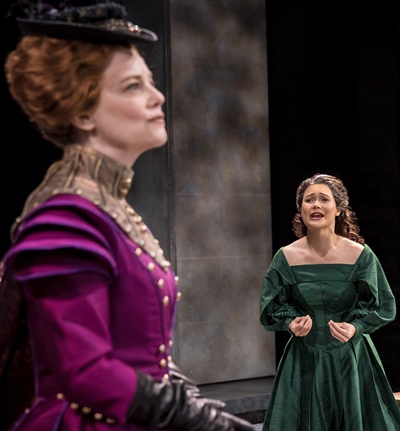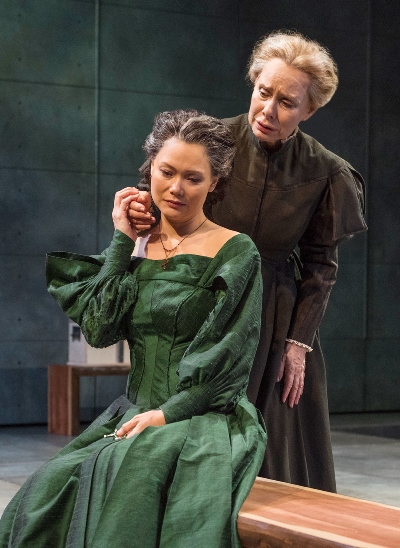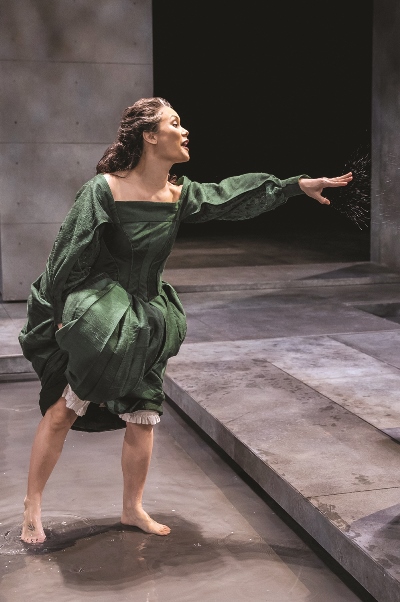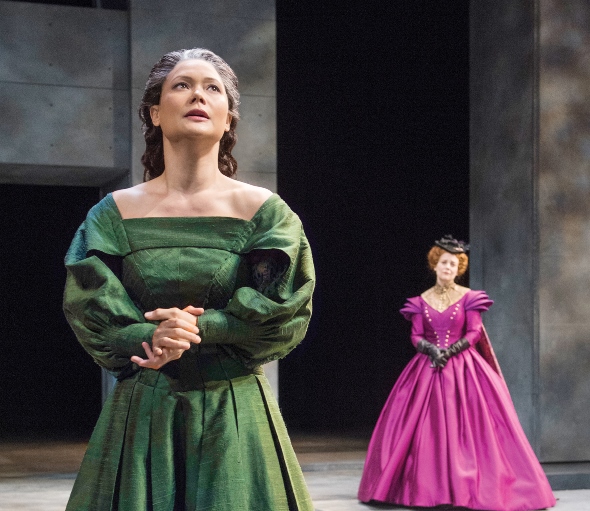Role Playing: K.K. Moggie, as Scottish queen Mary Stuart, got to a royal heart layer by layer
Interview: In title role of Schiller’s play at Chicago Shakespeare, actress found the lioness in the skin of a tender, vulnerable woman.
By Lawrence B. Johnson
Like the queen she plays, K.K. Moggie rules the stage in the title role of Schiller’s “Mary Stuart” at Chicago Shakespeare Theater. But what helped her get to that place, she says, was the realization that the play was less about the fallen Scottish queen – who aspires to the English throne even as she is held prisoner by Queen Elizabeth – than what’s going on around her.
“That sudden understanding seemed to relieve a great deal of pressure and allow me to connect with this complex female,” says Moggie of the famously beautiful 16th-century monarch whose very life now lies in the hands of her fully empowered rival Elizabeth. “There is a softness about Mary, a vulnerability and tenderness, but she’s also a lioness with the deep quality of a survivor.”
 In Schiller’s play, originally in German and first produced in 1800, Mary has long languished under arrest, her former wealth stripped away and her only companion her faithful nurse from childhood (played by Barbara Robertson). Meanwhile, Elizabeth’s courtiers advise her both yea and nay on the issue of Mary’s life: While some urge Elizabeth to put her nemesis to death, others counsel forbearance lest she turn Mary into a martyr.
In Schiller’s play, originally in German and first produced in 1800, Mary has long languished under arrest, her former wealth stripped away and her only companion her faithful nurse from childhood (played by Barbara Robertson). Meanwhile, Elizabeth’s courtiers advise her both yea and nay on the issue of Mary’s life: While some urge Elizabeth to put her nemesis to death, others counsel forbearance lest she turn Mary into a martyr.
“When I came to the first table reading, I was well prepared. I’d done a great deal of research, and I felt like I had ownership of the role,” says Moggie. “But then (director) Jenn Thompson started working into the character of Mary layer by layer until the colors were deeper, more refined and specific. It’s not that I was on the wrong track, but rather that we took our time going through Mary’s every emotional journey by very fine degrees.
“I found that process to be liberating. For all the research I did, I found it was really Schiller’s creative imagination that gives us Mary’s character – and some amazing lines. She says, ‘Be careful not to mistake the advantages of the state for justice.’ That makes the story quite relevant for today, doesn’t it?”
What sets Elizabeth and Mary apart from each other is not just power and subjugation, Moggie observes, but their histories and temperaments:
 “We are really looking at two marvelous female creatures. Mary’s upbringing was of royal privilege. She lived at the French court from the age of 5. She grew up believing that her beauty and femininity were revered above all other qualities. She was the Kim Kardashian of her day. By the time we see her, she has lost everything. All she has left are her instincts and a conviction that she’s entitled to the crown Elizabeth now wears.
“We are really looking at two marvelous female creatures. Mary’s upbringing was of royal privilege. She lived at the French court from the age of 5. She grew up believing that her beauty and femininity were revered above all other qualities. She was the Kim Kardashian of her day. By the time we see her, she has lost everything. All she has left are her instincts and a conviction that she’s entitled to the crown Elizabeth now wears.
“Also, her deep Catholic faith is incorruptible,” Moggie continues. “Elizabeth (daughter of Henry VIII and played by Kellie Overbey) grew up in a competitive world where she had to rely on her sharp wits. She has a clinical mind and she’s an excellent judge of the people around her.”
Moggie attributes the concentrated power of “Mary Stuart” to the elegance and specificity of Peter Oswald’s English-language adaptation. Mostly, this updated and streamlined text preserves the blank verse and largely the iambic pentameter pulse of Schiller’s original work.
“Oswald’s writing is seamless,” she says. “The language pops. It is so easy to hear. We had our first high school performance recently, and the kids were right there with us. We had a lovely verse coach (Kathryn Walsh), and Jenn (the director) always reminding us not to fall behind the forward motion of that engine. Once on that train, you could feel it go – the melody, the rhythm, the musicality of the play.”
 Inevitably, Moggie’s perspective on the imprisoned and bereft but ever defiant Mary evolved with each performance. Or as she puts it, “a sense of ease and freedom” began to settle in.
Inevitably, Moggie’s perspective on the imprisoned and bereft but ever defiant Mary evolved with each performance. Or as she puts it, “a sense of ease and freedom” began to settle in.
“Because of the mountain I had to climb, I was initially leaning into the feisty, tenacious side of her,” she says, “but playing the role has allowed me to swing back around to her softer parts, to even her out. I’ve found a kind of charisma in her that has allowed audiences to jump onto her side a lot earlier. By the time I get to the lioness coming, I know I can really let go. They will feel it as much as Mary does in that moment.”
The lioness is Mary transformed into a force of nature when Elizabeth shows up to confront her prisoner, unexpected and unannounced. Such a face to face meeting has been Mary’s fondest wish. But she’s utterly unprepared for it, and unwittingly set up for it. Elizabeth and her retinue come upon Mary just outside her prison walls, where she has been granted unusual freedom to revel in the sunlight and splash in a shallow pool. The meeting does not go well as Mary quickly erupts in a towering rage. That scene, says Moggie, is the highest hurdle she must clear at every performance.
 “This is where we put in our hardest work, and it’s different every night. Kellie (as Elizabeth) is so great to work with. We can really play ball. And there are so many different emotional responses happening at the same time. Imagine, this is a meeting 19 years in the making, and it’s fully charged. You have all these things you’re turned over in your head for so long, all these things you want to say – then the meeting suddenly, unexpectedly happens, and all that goes out the window.
“This is where we put in our hardest work, and it’s different every night. Kellie (as Elizabeth) is so great to work with. We can really play ball. And there are so many different emotional responses happening at the same time. Imagine, this is a meeting 19 years in the making, and it’s fully charged. You have all these things you’re turned over in your head for so long, all these things you want to say – then the meeting suddenly, unexpectedly happens, and all that goes out the window.
“That’s what’s so wonderful about the scene, this emotionally vibrant connection that everyone in the audience makes. It’s always the scene I have the most nerves about and the greatest high from. There’s so much adrenaline, so much trepidation beforehand: how much breathing I need to do, how warm my body has to be.
“On top of all the rest, Mary is subjected to an attempted rape, all in the ginormous arc of one scene. When I come off stage, a stage hand is waiting with shoes and a glass of water. But I’m bent over just breathing for 15 seconds. Then I put on my shoes, have a drink and walk back to my dressing room.”
Related Links:
Review of ‘Mary Stuart’: Read it at Chicago On the Aisle
More Role Playing interviews:
- Kathleen Ruhl went for laughs, but resisted harsh character that gets them
- Kate Fry’s vivid Emily Dickinson sprang from poet’s fine-tuned, evocative verse
- Joel Reitsma drew moral profit from banker-captor clash of ‘Invisible Hand’
- Lawrence Grimm found Lincoln first in pages of history, then within himself
- Cristina Panfilio spreads wings she didn’t know she had as midsummer Puck
- Tyla Abercrumbie was set to run little ‘Hot Links’ café, but why was she there?
- AnJi White, as Catherine Parr, learned to keep her wits – to keep her head
- Adam Bitterman, unlikely florist in ‘Seedbed,’ dug deep to create a rare bloom
- Danny McCarthy, pushing broom in ‘The Flick,’ finds vital pulse in long silences
- Mierka Girten, actor with MS, knows wound behind her character’s scars
- Sandra Marquez, as Clytemnestra, sees an exceptional woman in the Greek queen
- Brian Parry says he summoned courage before wit as George in ‘Virginia Woolf’
- Tracy Michelle Arnold debunks madness as force that drives Blanche DuBois
- Christopher Donahue, as Ahab, finds sea’s depth in sadness of a vengeful soul
- Lance Baker embodies ennui, despair of fugitive Jews in ‘Diary of Anne Frank’
- Francis Guinan embraces conflict of father who fled from grim truth in ‘The Herd’
- Sophia Menendian reached back (but not far) as plucky Armenian refugee of 15
- Lindsey Gavel’s distressed Masha, in ‘Three Sisters,’ began with a touch of cheer
- Hollis Resnik felt personal bond with zealous, skeptical scholar in ‘Good Book’
- A.C. Smith is ready undertaker, lord of diner world in ‘Two Trains Running’
- Lia D. Mortensen’s intense portrait of a mentally failing scientist holds mirror to life
- Siobhan Redmond sees re-formed Lady Macbeth as valiant queen in ‘Dunsinane’
- Eileen Niccolai harnessed a storm of emotions to create spark in Williams’ Serafina
- Steve Haggard, aiming at reality, strikes raw core of grieving man in ‘Martyr’
- Shannon Cochran found partners aplenty in sardonic, twice-told ‘Dance of Death’
- Natalie West scaled back comedy to nail laughs, touch hearts in ‘Mud Blue Sky’
- Dave Belden, actor and violinist, adjusted pitch for ‘Charles Ives Take Me Home’
- Joseph Wiens starts at full throttle to convey alienation of ‘Look Back in Anger’
- Shane Kenyon touches charm and hurt of lovable loser in Steep’s ‘If There Is’
- Ramón Camín sees working class values in Arthur Miller’s tragic Eddie Carbone
- Hillary Marren’s charming, rapping witch in ‘Woods’ shapred by hard work, free play
- Mary Beth Fisher embraces both hope, despair of social worker in ‘Luna Gale’
- Brad Armacost switched brothers to do blind, boozy character in ‘The Seafarer’
- Karen Woditsch shapes vowels, flings arms to perfect portrait of Julia Child
- Ora Jones had to find her way into Katherine’s frayed world in ‘Henry VIII’
- Kareem Bandealy tapped roots, hit books for form warlord in ‘Blood and Gifts’
- Eva Barr explored two personas of Alzheimer’s victim to find center of ‘Alice’
- Darrell W. Cox sees theater’s core in closed-off teacher of ‘Burning Boy’
- Chaon Cross turned Court stage into a romper room finding answers in ‘Proof’
- Dion Johnstone turned outsider Antony to bloody purpose in ‘Julius Caesar’
- Noir films gave Justine Turner model for shadowy dame in ‘Dreadful Night’
- Anish Jethmalani plumbs agony of good man battling demons in ‘Bengal Tiger’
- Gary Perez channels his Harlem youth as quiet, unflinching Julio in ‘The Hat’
- Kamal Angelo Bolden sharpened dramatic combinations to play ‘The Opponent’
- In wheelchair, Jacqueline Grandt explores paralysis of neglect in ‘Broken Glass’
- James Ridge thrives in cold skin of Shakespeare’s smiling serpent, Richard III
- Stephen Ouimette brews an Irish tippler with a glassful of illusions in ‘Iceman’
- Ian Barford revels in the wiliness of an ambivalent rebel in Doctorow’s ‘March’
- Chuck Spencer flashes a badge of moral courage in Arthur Miller’s ‘The Price’
- Rebecca Finnegan finds lyrical heart of a lonely woman in ‘A Catered Affair’
- Bill Norris pulled the seedy bum in ‘The Caretaker” from a place within himself
- Diane D’Aquila creates a twice regal portrait as lover and monarch in ‘Elizabeth Rex’
- Dean Evans, in clown costume, enters the darkness of ‘Burning Bluebeard’
- Dan Waller wields a personal brush as uneasy genius of ‘Pitmen Painters’
- City boy Michael Stegall ropes wild cowboy in Raven Theatre’s ‘Bus Stop‘
- Brent Barrett is glad he joined ‘Follies’ as that womanizing, empty cad Ben
- Sadieh Rifai zips among seven characters in one-woman “Amish Project”
- Kirsten Fitzgerald inhabits sorrow, surfs the laughs in ‘Clybourne Park’
- Janet Ulrich Brooks portrays a Russian arms negotiator in ‘A Walk in the Woods’


